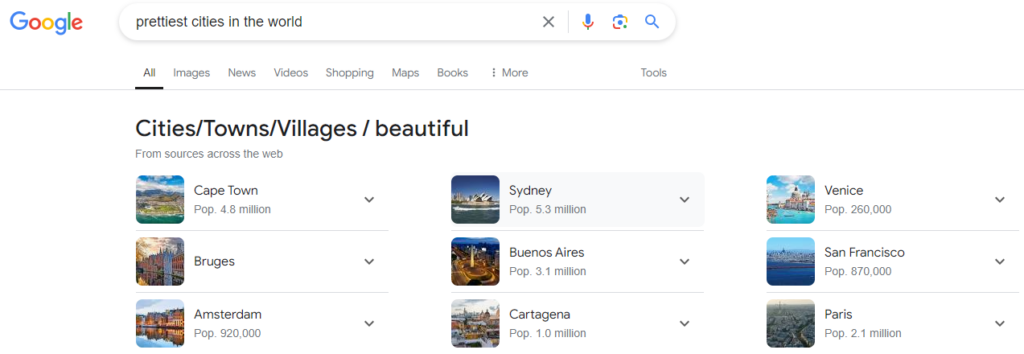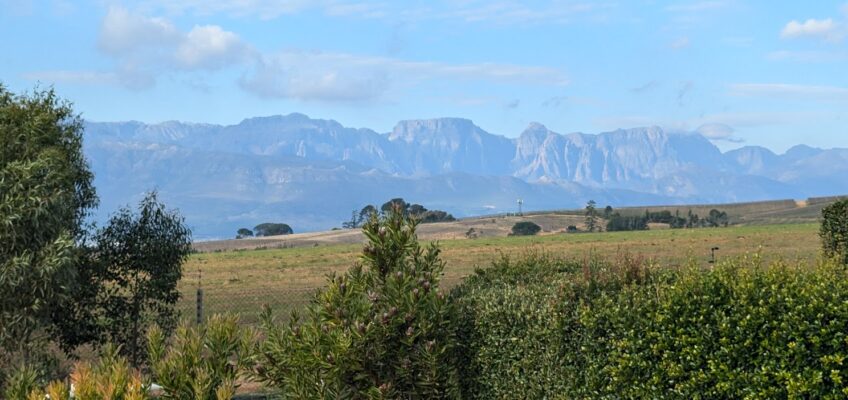Wednesday, July 24, 04:00
Yes, it’s 4am.
Yesterday I slept right up until my alarm went off at 7am. That was my first full night’s sleep of this trip.
But today I’m up again in the middle of the night. Rather than lying in bed hoping to get back to sleep, I’m writing.
This afternoon I asked Mary Ann if Cape Town has met, exceeded, or fallen short of expectations. She said, “Exceeded.”
I agree.
Just for kicks, I looked at several lists of prettiest cities in the world. Cape Town made every list and was in the top five in every one that ranked them.

It certainly helped that we’ve had perfect weather the entire time we’ve been here. Rather chilly, especially that first day riding on the HOHO bus. But sunny and pleasant.
Alas, now I can hear rain outside. So it is time to go. In 3 1/2 hours we’ll be on our way to the airport.
Green Point Park
We’d kept yesterday open to decide what we wanted to do. We settled on three things:
- A walking tour of downtown focusing on Cape Town history;
- A winery tour; and
- A production of Agatha Christie’s Witness for the Prosecution at Theatre on the Bay.
Since the walking tour didn’t start until 11:00, I had time in the morning to take a walk in Green Point Park, which is right behind the Dolphin Inn. Sometimes when I travel, it’s easy to forget to enjoy stuff that isn’t “important” or “must-see.” I really hate the term “must-see” anyway. Nothing is “must-see.”
In any case, the park offered an opportunity to just enjoy seeing birds and flowers and a pleasant walk. One of my favorite moments was standing by a pond and listening to the peepers and croakers as a flock of ducks flew quacking overhead.
Walking tour
Since this was a historical walking tour, it wasn’t so much about seeing the sights as it was a look into the history of the city and the area. Cape Town history is truly fascinating. I learned a lot. The shame of Apartheid is just one chapter in the terrible history of this country. And its legacy survives today in the form of overcrowded neighborhoods of corrugated steel shacks. We saw some of these on the HOHO yesterday and on our way to the wineries in the afternoon.
South Africa also has a history of slavery. During the Dutch period land couldn’t be bought or sold. It was managed by the Dutch East India Company. So wealth came through buying and selling human beings.
I was surprised to learn that South Africa was never a Dutch colony. It was the Dutch East India Company that operated here. They arrived in 1652, and they flew their own flag, not the flag of the Netherlands.
The British came in the late 18th and early 19th centuries, and soon this became a British colony.
The Portuguese
Oh, but I forgot to mention the Portuguese. They came first, but they didn’t land here. Bartolomeu Dias passed around the horn of Africa in 1488, but turned back before going much farther. On returning to Portugal he told King John II that they named the peninsula Cape of Storms. The king said no, we can’t call it that, and he named it the Cape of Good Hope because it symbolized the opening of a sea route to the east. (This story was told to us by our guide, but it may just be legend.)
Vasco da Gama was the first European to reach India by sea, passing the Cape of Good Hope in 1497.
The next time the Portuguese came, led by Francis de Almeida in 1510, they finally landed in search of fresh water. Our guide described what happened, but I found this account online, which I think gives a clearer picture:
Some of his crew went to a nearby Khoikhoi settlement in the area around Salt River to trade for cattle and sheep. When the sailors attempted to kidnap two Khoi children and cattle, an armed conflict ensued. The sailors were driven back to their ships, ending in victory for the Khoikhoi.
De Almeida sent a punitive expedition of one hundred and fifty men to deal with the Khoikhoi. After the expedition had set fire to Khoikhoi huts, they were surrounded by a band of Khoikhoi armed with arrows and assegais. The Portuguese force was overwhelmed and defeated, leaving 67 Portuguese sailors including de Almeida dead. Conflicts with the Khoikhoi prompted the Portuguese to avoid the Table Bay area.
Supposedly the returning sailors made no mention of their attempt to kidnap the children.
More recent history
No more Europeans came here for a hundred years! Then came the Dutch East India Company, and then the British. The Cape Colony was formally ceded to Britain at the end of the Napoleonic wars. British settlers began to arrive in large numbers starting in 1818. Dutch settlers migrated to other areas of what is now South Africa, forming the Boer Republics.
The British didn’t get along with anyone. They fought successfully against the Zulus in 1879 and against the Boers in two wars (1880–81, which they lost, and 1899–1902, which they won).
In 1910 the British granted limited independence to the Union of South Africa, a federation of the former Cape Colony and the Boer Republics. In 1934 the Union became a sovereign state within the British empire. Apartheid was established as official policy in 1948. In 1961 the country became a Republic; it left the British Commonwealth in 1968.
When the Apartheid era ended in the 1990s, the Republic of South Africa rejoined the Commonwealth. The transition to racial equality has been gradual and difficult, but my impressions are that things are improving.
Photos from the tour
Currently a museum about the history of slavery in South Africa, this was the original slave lodging, built in 1679, making it the second oldest colonial building in the city.
The original building was completed in 1884, with additions constructed in the 1920s and 1980s. The newer additions house the National Assembly (the lower house of the bicameral Parliament of South Africa), and the original building houses the National Council of Provinces (the upper house of Parliament).
Winery Tour
The winery tour was enjoyable, mostly because the other four people were enjoyable to get to know. Some of the wines we tasted were quite good, and there was some pleasant scenery.

Theatre
The production was excellent!
Our visit to Cape Town started as something of an afterthought in our safari planning. Since we had to fly here on our way to Maun, Botswana, we figured we might as well stay a few days.
I’m so glad we did.
I think another few days would be warranted for time to visit Robben Island and some museums and learn some more about this fascinating country. Racial equality has only been a thing here for 30 years, and yet in so many ways it feels like they have progressed further than the US has since the Civil War.
About this post
I didn’t blog during this trip, but I kept a journal. All my posts consist of journal entries I wrote during the trip and transcribed into this blog after I got home, with some editing and embellishing.
This post in particular has a lot of embellishment written after I arrived home. I added a great deal of historical detail that wasn’t part of my journal.


Leave a Reply